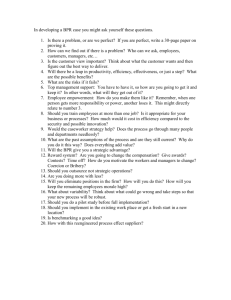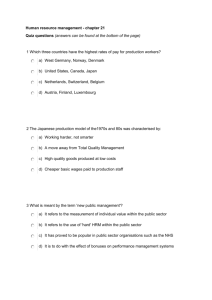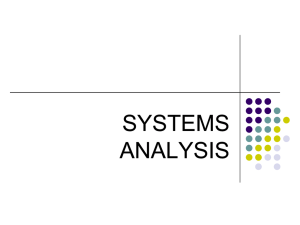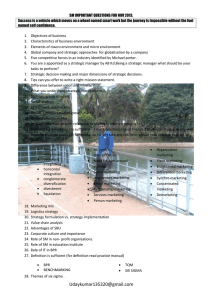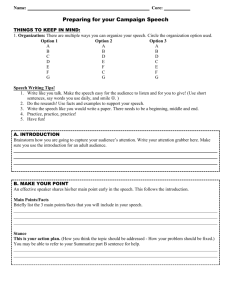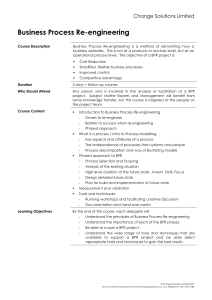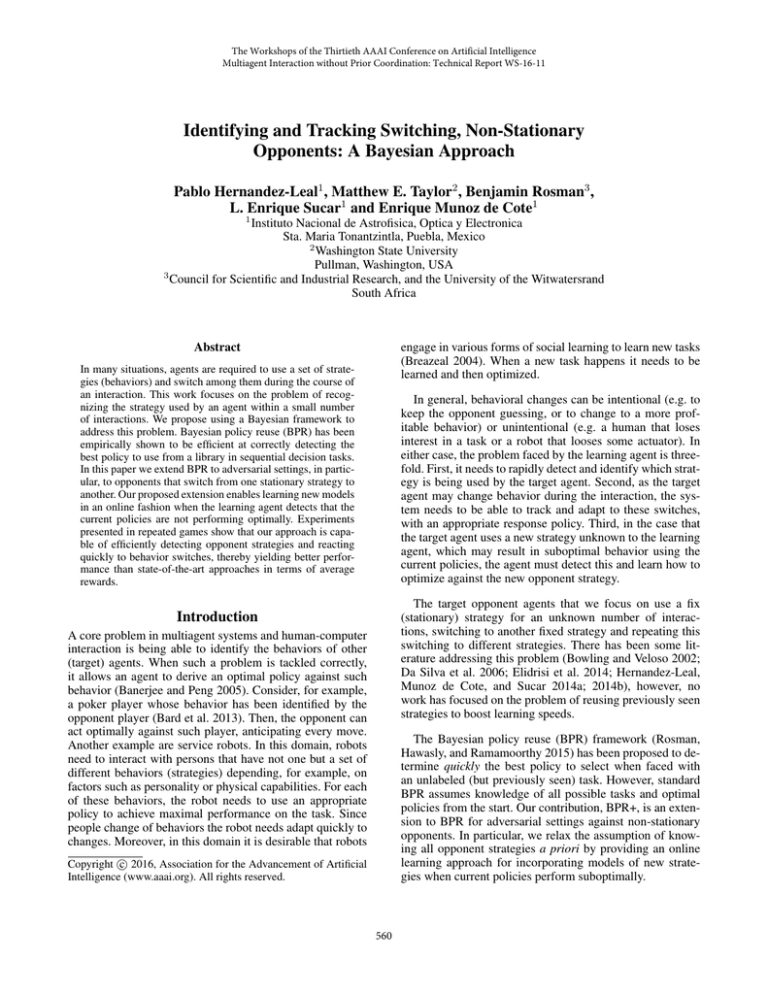
The Workshops of the Thirtieth AAAI Conference on Artificial Intelligence
Multiagent Interaction without Prior Coordination: Technical Report WS-16-11
Identifying and Tracking Switching, Non-Stationary
Opponents: A Bayesian Approach
Pablo Hernandez-Leal1 , Matthew E. Taylor2 , Benjamin Rosman3 ,
L. Enrique Sucar1 and Enrique Munoz de Cote1
1
Instituto Nacional de Astrofisica, Optica y Electronica
Sta. Maria Tonantzintla, Puebla, Mexico
2
Washington State University
Pullman, Washington, USA
3
Council for Scientific and Industrial Research, and the University of the Witwatersrand
South Africa
Abstract
engage in various forms of social learning to learn new tasks
(Breazeal 2004). When a new task happens it needs to be
learned and then optimized.
In many situations, agents are required to use a set of strategies (behaviors) and switch among them during the course of
an interaction. This work focuses on the problem of recognizing the strategy used by an agent within a small number
of interactions. We propose using a Bayesian framework to
address this problem. Bayesian policy reuse (BPR) has been
empirically shown to be efficient at correctly detecting the
best policy to use from a library in sequential decision tasks.
In this paper we extend BPR to adversarial settings, in particular, to opponents that switch from one stationary strategy to
another. Our proposed extension enables learning new models
in an online fashion when the learning agent detects that the
current policies are not performing optimally. Experiments
presented in repeated games show that our approach is capable of efficiently detecting opponent strategies and reacting
quickly to behavior switches, thereby yielding better performance than state-of-the-art approaches in terms of average
rewards.
In general, behavioral changes can be intentional (e.g. to
keep the opponent guessing, or to change to a more profitable behavior) or unintentional (e.g. a human that loses
interest in a task or a robot that looses some actuator). In
either case, the problem faced by the learning agent is threefold. First, it needs to rapidly detect and identify which strategy is being used by the target agent. Second, as the target
agent may change behavior during the interaction, the system needs to be able to track and adapt to these switches,
with an appropriate response policy. Third, in the case that
the target agent uses a new strategy unknown to the learning
agent, which may result in suboptimal behavior using the
current policies, the agent must detect this and learn how to
optimize against the new opponent strategy.
The target opponent agents that we focus on use a fix
(stationary) strategy for an unknown number of interactions, switching to another fixed strategy and repeating this
switching to different strategies. There has been some literature addressing this problem (Bowling and Veloso 2002;
Da Silva et al. 2006; Elidrisi et al. 2014; Hernandez-Leal,
Munoz de Cote, and Sucar 2014a; 2014b), however, no
work has focused on the problem of reusing previously seen
strategies to boost learning speeds.
Introduction
A core problem in multiagent systems and human-computer
interaction is being able to identify the behaviors of other
(target) agents. When such a problem is tackled correctly,
it allows an agent to derive an optimal policy against such
behavior (Banerjee and Peng 2005). Consider, for example,
a poker player whose behavior has been identified by the
opponent player (Bard et al. 2013). Then, the opponent can
act optimally against such player, anticipating every move.
Another example are service robots. In this domain, robots
need to interact with persons that have not one but a set of
different behaviors (strategies) depending, for example, on
factors such as personality or physical capabilities. For each
of these behaviors, the robot needs to use an appropriate
policy to achieve maximal performance on the task. Since
people change of behaviors the robot needs adapt quickly to
changes. Moreover, in this domain it is desirable that robots
The Bayesian policy reuse (BPR) framework (Rosman,
Hawasly, and Ramamoorthy 2015) has been proposed to determine quickly the best policy to select when faced with
an unlabeled (but previously seen) task. However, standard
BPR assumes knowledge of all possible tasks and optimal
policies from the start. Our contribution, BPR+, is an extension to BPR for adversarial settings against non-stationary
opponents. In particular, we relax the assumption of knowing all opponent strategies a priori by providing an online
learning approach for incorporating models of new strategies when current policies perform suboptimally.
c 2016, Association for the Advancement of Artificial
Copyright Intelligence (www.aaai.org). All rights reserved.
560
Related Work
Table 1: Bimatrix representing the prisoner’s dilemma: two agents
chose between two actions, cooperate and defect.
Cooperate Defect
Cooperate
c, c
s, d
Defect
d, s
p, p
Our work relates to learning in non-stationary environments, since switches between stationary environments are
a special case of non-stationarity. The win or learn fast
(WOLF) idea was introduced to adapt to learning algorithms. WOLF-PHC (Bowling and Veloso 2002) is an extension of Q-learning that performs hill-climbing in the space of
mixed policies. This algorithm was designed for converging
with opponents that slowly change behavior, without sudden strategy changes. A related approach is reinforcement
learning with context detection (RL-CD) (Da Silva et al.
2006), which learns several partial models and selects one to
use depending on the context of the environment. However,
this has not been tested in multiagent scenarios. Hiddenmode Markov decision processes (HM-MDPs) (Choi, Yeung, and Zhang 1999) assume the environment —in our case
an opponent behavior— can be represented using a small
number of modes (each representing a stationary environment), which have different dynamics and therefore need
different policies. At each time step only one mode is active, and modes cannot be directly observed. HM-MDPs
require the solution of a POMDP to obtain a policy, they
are not capable of learning new models online and are hard
to solve in general (PSPACE-complete) (Papadimitriou and
Tsitsiklis 1987). The fast adaptive learner (FAL) approach
(Elidrisi et al. 2014) has focused on fast learning in twoperson stochastic games. It maintains a set of hypotheses
according to the history of observations in order to predict
the opponent’s action. To obtain a strategy against the opponent, they use a modified version of the Godfather strategy
(Littman and Stone 2001) which restricts its use. Additionally, FAL experiences an exponential increase in the number
of hypotheses (in the size of the observation history), which
may limit its use in larger domains. The MDP-CL framework (Hernandez-Leal, Munoz de Cote, and Sucar 2014a) is
a model-based approach to handle switching opponents. It
learns an opponent strategy as a stationary environment, inducing an MDP based on the interaction history. Solving that
MDP provides an optimal policy to act. To detect opponent
switches MDP-CL learns a different model periodically and
compares it to the current model to evaluate their similarity. If the distance between models is greater than a threshold, it is considered that the opponent has changed strategy and it must restart the learning phase. A priori MDPCL (Hernandez-Leal, Munoz de Cote, and Sucar 2014b)
assumes the set of possible strategies Mi (represented by
MDPs) used by the opponent is known. The problem, similar to our scenario, is to detect quickly the strategy used
by the opponent and adapt to possible switches. In a priori
MDP-CL, the correct model will have a perfect similarity
with at least one of the Mi models with enough experience
tuples. When this happens, it stops the random exploration
phase, and computes a policy against it. A limitation of a
priori MDP-CL is that it explores randomly until reaching a
perfect similarity with one of the Mi models.
In contrast to previous approaches, BPR+ uses the information of how the policies behave to guide the exploration,
potentially reducing the time to detect the model.
Preliminaries
Our approach is developed in the context of repeated games.
Consider two players (A and B) that face each other and
repeatedly play a bimatrix game. A bimatrix game is a
two player simultaneous-move game defined by the tuple
hA, B, RA , RB i, where A and B are the set of possible actions for player A and B respectively, and Ri is the reward
matrix of size |A|×|B| for each agent i ∈ {A, B}, where the
payoff to the ith agent for the joint action (a, b) ∈ A × B is
given by the entry Ri (a, b), ∀(a, b) ∈ A × B, ∀i ∈ {A,B}. A
stage game is a single bimatrix game and a series of rounds
of the same stage game form a repeated game. A strategy
specifies a method for choosing an action. A best response
for an agent is the strategy (or strategies) that produce the
most favorable outcome for that player, taking other players’ strategies as given.
The prisoner’s dilemma is a well-studied two player game
where the interactions can be modeled as a symmetric twoplayer game defined by the payoff matrix in Table 1 where
the following two conditions must hold d > c > p > s and
2c > d + s. When both players cooperate they both obtain
the reward c. When both defect, they receive a punishment
reward p. A player choosing to cooperate with someone who
defects receives the sucker’s payoff s, whereas the defecting
player gains the temptation to defect, d. The iterated version
(iPD) has been subject to many studies, including human
trials. One well-known strategy for iPD is called Tit-for-Tat
(TFT) (Axelrod and Hamilton 1981), which starts by cooperating, and thereafter chooses the action taken by the opponent in the previous round. Another successful strategy is
called Pavlov, which cooperates if both players previously
coordinated with the same action and defects whenever they
did not. Bully (Littman and Stone 2001) is another wellknown strategy involving always behaving as a defecting
player.1 We use this game for experimentation, as we can
use the documented strategies to build switching opponents.
Bayesian Policy Reuse
Bayesian Policy Reuse (Rosman, Hawasly, and Ramamoorthy 2015) has been proposed as a framework to determine
quickly the best policy to select when faced with an unknown task. Formally, a task is defined as an MDP, M =
hS, A, T, Ri, where S is the set of states, A is the set of actions, T is the transition function and R is the reward function. A policy is a function π(s) that specifies an appropriate action a for each state s. The return, or utility, generated
from running the policy π in an interaction of a task instance
Pk
is the accumulated reward, U π = i=0 ri , with k being the
1
These strategies can be defined only by the current state and
do not depend on the time index; they are stationary strategies.
561
BPR+
length of the interaction and ri being the reward received
at step i. Solving an MDP M is to acquire an optimal policy π ? = arg max Uπ which maximizes the total expected
return of M.
Let an agent be a decision making entity in some domain,
and let it be equipped with a policy library Π for tasks in that
domain. The agent is presented with an unknown task which
must be solved within a limited and small number of trials.
At the beginning of each trial episode, the agent can select
one policy from π ∈ Π to execute. The goal of the agent is
thus to select policies to minimize the total regret incurred
in the limited task duration with respect to the performance
of the best alternative from Π in hindsight.
In order to select which policy will be used, different
mechanisms can be used. A heuristic for policy selection
V is a function that estimate a value for each policy which
measures the extent to which it balances exploitation with a
limited degree of look-ahead for exploration.
The probability of improvement heuristic for policy selection is through the probability with which a specific policy can achieve a hypothesized increase in performance over
P
the current best estimate, Û t (π) = τ ∈O β t (τ )E[U |τ, π].
thus, the heuristic chooses the policy that maximizes
P
arg maxπ∈Π τ ∈O β(τ )E[U + |τ, π] where U + > Û t (π).
BPR assumes knowledge of performance models describing how policies behave on different tasks. A performance
model P (U |τ, π) is a probability distribution over the utility
using π on a task τ . A signal σ is any information that is correlated with the performance of a policy and that is provided
to the agent in an online execution of the policy on a task
(e.g., the immediate reward). For a set of tasks O and a new
instance τ ? the belief β is a probability distribution over O
that measures to what extent τ ? matches the known tasks in
their observation signals σ. The belief is initialized with a
prior probability. After each execution on the unknown task
the environment provides an observation signal to the agent,
which is used to update beliefs according to Bayes’ rule:
β t (τ ) = P
This section describes BPR+, which handles non-stationary
opponents and learns new models in an online manner. BPR
was presented in a single agent environment facing different
tasks (represented by MDPs). BPR+ extends to a multiagent
setting. Now the tasks correspond to opponent strategies and
the policies correspond to optimal policies against those stationary strategies. To cope with these new type of environment, some considerations need to be taken, (i) an exploration for switch detection is added: drift exploration. (ii) A
method for detecting when an unknown opponent strategy
appears is needed. (iii) A method for learning the new opponent strategy (and then an new optimal policy). (iv) An algorithm for updating the performance models to add the information from the recently learned model and policy. These
points are presented in more detail in the following sections.
Drift exploration and switch detection
Against non-stationary opponents, exploration cannot be terminated, as is often the case (Munoz de Cote et al. 2010).
In fact it is critical since strategy switches can be difficult
to detect, particularly if the strategies in question are very
similar. Such similarities can produce a “shadowing” effect
(Fulda and Ventura 2006) in the agent’s perception — an
agent’s optimal policy π ? will produce an ergodic set of
states against some opponent strategy, but if the opponent’s
switching strategy induces a similar MDP where the policy π ? produces the same ergodic set, the agent will not detect something has changed (unless some new kind of exploration occurs).
Definition 1 Drift exploration is a type of exploration tailored for non-stationary environments that guarantees that
opponent switches will not pass unnoticed.
BPR+ uses “drift exploration” that solves this shadowing
effect by exploring the state space even after an optimal policy has been learned. -greedy or softmax exploration are
useful approaches to drift exploration.
Recall that BPR obtains information from every interaction to update its belief. Against stationary opponents, the
belief may converge to a perfect score and the probability
of alternative opponent models will drop to zero. However,
with non-stationary opponents, we require that the belief
may be able to increase to handle opponent switches. To
solve this, BPR+ restricts all beliefs to not drop to zero by
adding a small γ > 0 value.
P (σ t |τ, π t )β t−1 (τ )
t
t
t−1 (τ ).
τ 0 ∈O P (σ |τ, π )β
In summary, BPR starts with a set of policies Π and
faces different tasks O. BPR is given performance models
P (U |O, Π) for how each policy behaves over each task.
BPR initializes the belief over tasks, and for each episode
of the interaction BPR selects a policy to execute (according to the belief and exploration heuristic) and receives an
observation signal σ which is used to update the belief.
Other policy reuse algorithms exist, e.g. in the work of
(Fernández and Veloso 2006), but their approach uses policy reuse to seed learning of new, similar behaviors, which
is slower, whereas we assume that these will be directly
reused; neither have been used against non-stationary opponents. Multi-armed bandits (Gittins 1979) are another related approach. However, one major difference is that the
performance and signal models allow us to keep more detailed information about how the different arms (policies) in
bandits relate to each other leading to faster convergence.
New model detection
We additionally consider the case where the opponent is
employing a novel strategy, necessitating model learning.
This scenario is identified through receiving a sequence of
rewards which are unlikely given the known performance
models.
Let rπi be the immediate reward obtained in round i using policy π. The probability of obtaining rπi given an opponent strategy τ using policy π is (given by the performance models): pτi = P (rπi |τ, π). Let p̂τi be the moving
average of rewards received during rounds i − n, . . . , i:
P
pτ
p̂τi = j=1,...,n i−j
n .
562
If, for all opponent strategies τ , p̂τi < ρ in the last n steps,
then BPR+ begins to learn a new model. Both ρ and n are parameters of the algorithm, the former controls how different
the probabilities need to be (compared to the known opponent strategies) and the latter controls the number of rounds
needed before consider learning a new opponent strategy. In
summary, BPR+ computes the probability of the rewards under the known models, and if this probability is lower than
a threshold (ρ) for some number of rounds (n), then a new
model will be learned.
D,1,d
Copp ,C learn
C opp ,D learn
C,1,c
C,1,c
C,1,s
C,1,s
Dopp ,Clearn
D,1,p
D,1,d
D,1,p
D opp ,D learn
Figure 1: An induced MDP representing the opponent’s dynamics.
An arrow represents transition, action and reward of the learning
agent.
Learning opponent strategies
(M) and optimal policies Π against those opponent strategies. BPR+ is also capable of detecting a switch to a strategy
which is not in O. The problem is then how to add the information from this new strategy Onew (and the obtained optimal policy, πnew ) to the current set of performance models.
This requires a series of steps in the set of performance
models. These are divided into different groups: (1) the
known performance models P (U |O, Π) (could be ∅), (2)
the performance models using initial policies against the
new opponent strategy P (U |Onew , Π), (3) the performance
model of the new strategy using the new optimal policy P (U |Onew , πnew ), and (4) the information from the
new optimal policy against the previously known opponent
strategies P (U |O, πnew ).
After detecting a new opponent strategy, BPR+ starts an
exploratory phase to learn it (the MDP). This MDP is used
to: i) obtain the performance models using the initial policies (group 2), ii) obtain a new optimal policy πnew which
is added to the set Π and a new performance model is obtained (group 3) and iii) obtain the performance models of
the initial opponent strategies with the newly computed policy (group 4). Now BPR+ can optimize its policy against the
new opponent and at the same time its performance models
are updated accordingly to be able to detect switches to either a new or a previously known strategy. A summary of
this process is presented in Algorithm 1 and the complete
BPR+ algorithm is shown in Algorithm 2.
After BPR+ detects a new strategy it needs to learn an optimal policy to be used. The opponent behavior is modeled
trough an MDP, Mnew , composed of hS, A, R, T i where S
is the set of states S = ×zi ∈Z zi , i.e. each state is formed
by the cross product of a set of attributes Z. We assume
to know these attributes, for example in the iPD these can
be the last action of each agent. A is the action set of the
learning agent. The transition function T : S × A → S is
0
)
0
learned using counts T̂ (s, a, s0 ) = n(s,a,s
m(s,a) with n(s, a, s )
the number of times the agent was in state s, used action
a and arrived at state s0 , m(s, a) is defined as the number
of times the agent was in state s and used action a. P
The rer(s,a)
ward function R is learned similarly: R̂(s, a) = m(s,a)
with r(s, a) the reward obtained by the agent when being
in state s and performing action a. In Figure 1, a learned
MDP with four states is depicted, it represents the model of
an opponent that uses the Pavlov strategy in the iPD game
(using rewards shown in Table 1). Each state is formed by
the last play of both agents, C for cooperate, D for defect,
subindices opp and learn refer to the opponent and the learning agent respectively (other attributes can be used for different domains), with arrows indicating the triplet: action,
transition probability and immediate reward for the learning
agent. Note that the last play defines the state of the learning
agent.
To learn the parameters of the MDP an exploratory phase
is needed (for example, with random actions). We assume
the opponent will not change of strategies during the learning phase (a number of rounds) after which an MDP that represents the opponent strategy is obtained. Since the rewards
are deterministic, solving the MDP induced by the opponent
is done through value iteration (Bellman 1957), obtaining
?
an optimal policy πnew
(Puterman 1994). If the model correctly represents the opponent’s strategy, the policy against
that opponent will result in a maximization of total rewards
against the opponent strategy.
Once Mnew is obtained, a performance model can be
computed: a policy π can be simulated on Mnew , representing the opponent O to produce a list of rewards
r0 , r1 , . . . , rn . These values are modeled as a probability
distribution (we used a Gaussian distribution) to obtain the
performance model P (U |O, π).
Algorithm 1: Learning of performance models in BPR+
1
2
3
4
5
6
7
Input: Known performance models P (U |O, Π) (group 1), opponent models
M and optimal policies Π
if new opponent strategy detected, Onew ∈
/ O then
Learn opponent strategy Mnew and solve to get optimal policy πnew .
Compute P (U |Onew , Π) with old policies (models in group 2).
Compute P (U |Onew , πnew ) (models in group 3).
Compute P (U |O, πnew ) using πnew on models ∈ M (models in
group 4).
Π = Π ∪ πnew
M = M ∪ Mnew
Example 1 Assume that BPR+ agent is playing the iPD
against a non-stationary opponent which uses TFT, Pavlov
and Bully strategies (O). BPR+ has faced the opponent
strategies TFT and Pavlov. Thus, BPR+ has the models of
those strategies, M, its optimal policies against those Π,
and the performance models (represented by Gaussians)
Updating performance models
Consider the following scenario. BPR+ is given an initial
set of performance models P (U |O, Π), its associated MDPs
563
(a) BPR+ belief against Bully (b) Average rewards when opponent is Bully
(a) BPR+ belief for opponent (b) Average rewards for oppoTFT-Bully
nent TFT-Bully
Figure 2: Beliefs of BPR+ against the stationary opponent Bully.
Figure 3: Belief and rewards of BPR+ against opponents that
Immediate rewards of BPR+ and a priori MDP-CL against opponent Bully Error bars represent one standard deviation. BPR+ is
able to quickly identify a known opponent with high probability
and play optimally against it.
switch strategies in middle of the interaction of 100 trials. Error
bars represent one standard deviation. BPR+ is able to quickly
identify a known opponent that switch strategies during the interaction with high probability and play optimally against it.
P (U |O, Π) (as group 1). Then, the opponent changes to a
Bully strategy which is detected as new one. The model is
learned and its optimal policy is obtained (as described in
Section ). Finally, the performance models are updated as
described in Algorithm 1 (groups 2, 3 and 4).
Each repeated game consisted of 20 rounds and results
are averaged over 100 iterations. Figure 2 (a) depicts the belief of BPR+ for an opponent strategy Bully. Against Bully,
the belief for Bully reaches the maximum score in 3 steps.
When the opponent uses Pavlov, the belief for Pavlov is the
maximum of the three strategies, after step 4 although it does
not obtain the maximum belief (1.0). Analyzing individual
games reveals that BPR+ sometimes converges to TFT. This
is because Pavlov will appear as TFT (or vice versa) for histories of cooperation. It is important to note that even when
beliefs converge to the incorrect model (in some cases) the
rewards are optimal (in terms of best response) and against
all opponent strategies BPR+ obtained the maximum reward
in less than 5 steps. In contrast to a priori MDP-CL which
needs approximately 15 rounds to reach the optimal reward
against Bully and more than 20 rounds for Pavlov.
Algorithm 2: BPR+ algorithm
1
2
3
4
5
6
7
8
Input: Policy library Π, prior probabilities P (O), performance models
P (U |O, Π), episodes K, exploration heuristic V
Initialize beliefs β 0 (O) = P (O)
for episodes t = 1, . . . , K do
Compute vπ = V(π, β t−1 ) for all π ∈ Π
π t = argmaxπ∈Π vπ
Use πt against the opponent
Obtain observation signal σ t from environment
Update belief β t using Bayes’ rule and restrict to > 0
Check for new opponent strategy (Algorithm 1)
Non-stationary opponents
Now we play against non-stationary opponents that change
from one strategy to another during the interaction. The
game was increased to 100 rounds and BPR+ starts with the
complete set of performance models but it does not know
when the opponent switch will occur.
In Figure 3 (a) beliefs and (b) rewards are depicted for an
opponent that starts with the TFT strategy and changes to
Bully in the middle of the interaction (100 trials). BPR+ is
capable of detecting the switch within 3 rounds and thereafter obtains the new optimal reward, in contrast to a priori
MDP-CL which takes more than 30 rounds to reach the new
optimal score.
Table 2 presents results of BPR+ with and without drift
exploration in terms of immediate rewards. The drift exploration used explores more when the recent rewards are low
and reduces exploration when they are high (in order to detect Bully-TFT switches). Using this drift exploration notably improved the results against Bully-TFT and slightly
decreased performance against the other opponents, as expected. However, note that it is behaviorally similar to the
omniscient agent, detecting all switches rapidly. As conclusion we note that when an opponent switches between strategies different scenarios may occur: 1) the switch is detected
and BPR+ correctly uses a new policy, 2) the switch is not
Experiments
In this section we present experiments in the iPD with values c = 3, d = 4, s = 0, p = 1. Opponent strategies
are TFT, Pavlov and Bully. Optimal policies are different
against each strategy.2 Experiments are divided in four parts:
i) BPR+ against stationary opponents. ii) BPR+ is then evaluated against non-stationary opponents (showing the importance of drift exploration) and ii) finally we present experiments using the online learning approach.
Model detection against stationary opponents
In this setting, BPR+ is given the performance models and
optimal policies against Bully, TFT and Pavlov. BPR+ starts
with a uniform distribution over the opponent strategies. The
objective of BPR+ is to detect with high probability and
within a small number of rounds which opponent strategy
it is facing, and to use the appropriate response policy.
2
Optimal policies are always cooperate, Pavlov and always defect, against opponents TFT, Pablo and Bully, respectively.
564
Table 2: Average rewards with std. dev. (±) for different non-stationary opponents. Each opponent changes from one strategy to another in
the middle of the interaction in a repeated game of 100 rounds. Results are averaged over 100 trials. Statistical significance of BPR+ against
BPR+ without drift exploration, a priori MDP-CL and WOLF-PHC is represented respectively by ‡, ∗, and †.
Opponent
Omniscient
BPR+
BPR+ (without drift exp.) A priori MDP-CL WOLF-PHC
Bully-TFT
2.0
1.67 ± 0.24‡ ∗ †
0.99 ± 0.01
1.29 ± 0.23
1.09 ± 0.17
Bully-Pavlov
2.0
1.93 ± 0.02 ∗†
1.98 ± 0.01
1.75 ± 0.07
1.47 ± 0.19
Pavlov-TFT
3.0
2.99 ± 0.01∗†
2.99 ± 0.01
2.81 ± 0.21
2.09 ± 0.44
Pavlov-Bully
2.0
1.92 ± 0.02∗†
1.97 ± 0.01
1.70 ± 0.12
1.51 ± 0.28
TFT-Bully
2.0
1.90 ± 0.04 ∗†
1.95 ± 0.02
1.65 ± 0.11
1.34 ± 0.22
TFT-Pavlov
3.0
2.98 ± 0.03∗†
2.99 ± 0.02
2.81 ± 0.16
2.08 ± 0.38
Average
2.33
2.23 ± 0.06
2.15 ± 0.01
2.00 ± 0.15
1.60 ± 0.28
Pavlov
TFT
Bully
Pavlov
TFT
Bully
Table 3: Average rewards with std. dev. (±) of the learning agents
(average of 100 trials). The opponent changes strategy randomly
every 200 rounds. BPR+ starts without any information ∗, † represent statistical significance with a priori MDP-CL and WOLFPHC respectively.
Learning agent
Avg. rewards ± std.dev
Omniscient
2.32 ± 0.00
BPR+
2.17 ± 0.27 ∗†
A priori MDP-CL
2.11 ± 0.24
WOLF-PHC
1.77 ± 0.19
(a) Average belief of BPR+ (b) Average rewards of differagent
ent algorithms
Figure 4: The upper portion of each figure shows the opponent
and update its performance models. Values for parameters
were ρ = 0.8 and n = 7 (experimentally selected).
In the first experiment, BPR+ only has information about
TFT and Pavlov strategies. However, the opponent will use
the strategies TFT-Bully-Pavlov-Bully (changing every 100
rounds). Figure 4 depicts (a) the beliefs in BPR+ and (b) rewards3 for BPR+, a priori MDP-CL and WOLF-PHC. For
the known opponents (TFT and Pavlov) BPR+ takes about
4 rounds to reach the optimal reward. From round 100 the
opponent uses Bully which is not known to BPR+. The beliefs and rewards start oscillating, and BPR+ detects this as a
new opponent strategy. BPR+ then initiates a learning phase
which finishes at approximately round 160, at that point it
can compute an optimal policy against Bully. At round 300
the opponent returns to a Bully strategy. However, now the
BPR+ agent does not need to relearn it, but rather takes about
3 rounds to select the optimal policy. A priori MDP-CL takes
longer to obtain the optimal score when a switch happens but
it is capable of reaching the best score. WOLF-PHC shows
a slower convergence obtaining lower cumulative rewards.
Finally, we tested against an opponent that changes its
strategy randomly every 200 rounds in a game of 2000
rounds. Table 3, shows immediate rewards for the different
approaches (average of 100 trials). BPR+ has no prior information of the opponent (group 1 is ∅) nor initial policies.
Results show that BPR+ adapts faster to switches which results in statistically significant better scores.
strategies (thick line means a unknown strategy to BPR+) used at
every round. (a) BPR+ beliefs with incomplete performance models (b) BPR+, a priori MDP-CL and WOLF-PHC rewards
detected but it does not affect the rewards (e.g., switches between TFT and Pavlov), or 3) the switch is not detected,
i.e. the Bully-TFT opponent. Without drift exploration, the
agent is not capable of detecting the switch because TFT
behaves as Bully for histories of defection (shadowing behavior).
Table 2 compares BPR+ (with and without drift exploration), a priori MDP-CL, WOLF-PHC and the Omniscient
(perfect) agent that best responds immediately after a switch
against different non-stationary opponents. Results are the
average of 100 trials, bold typeface represents the best score
among learning algorithms. Statistical significance of BPR+
with a priori MDP-CL, WOLF-PHC and BPR+ (without
drift exploration) is indicated with ∗, † and ‡. From the results it can be noticed that BPR+ obtained the best scores
(significantly better) among the learning agents. One interesting case happens against the Bully-TFT, where not using
drift exploration in BPR+ causes the algorithm to not detect the switch (this is explained in more detail in the next
section). As shown previously, a priori MDP-CL is able to
adapt to the opponents but it requires more rounds to detect and learn the new opponent strategy, obtaining lower
rewards. WOLF-PHC obtained the worst results showing
slower convergence.
Conclusions
We propose a Bayesian approach to cope with nonstationary opponents (that change from one stationary strat-
Unknown strategies: online learning
This section evaluates BPR+ against a switching opponent
which uses unknown strategies. Now BPR+ must detect a
new strategy, learn the associated MDP, optimize against it
3
Note that in this domain an immediate reward greater than 3
can be obtained, however, this is not sustainable in the long term.
565
Hernandez-Leal, P.; Munoz de Cote, E.; and Sucar, L. E.
2014a. A framework for learning and planning against
switching strategies in repeated games. Connection Science
26(2):103–122.
Hernandez-Leal, P.; Munoz de Cote, E.; and Sucar, L. E.
2014b. Using a priori information for fast learning against
non-stationary opponents. In Advances in Artificial Intelligence – IBERAMIA 2014, 536–547.
Littman, M. L., and Stone, P. 2001. Implicit Negotiation in
Repeated Games. ATAL ’01: Revised Papers from the 8th
International Workshop on Intelligent Agents VIII.
Munoz de Cote, E.; Chapman, A. C.; Sykulski, A. M.; and
Jennings, N. R. 2010. Automated Planning in Repeated
Adversarial Games. Uncertainty in Artificial Intelligence
376–383.
Papadimitriou, C. H., and Tsitsiklis, J. N. 1987. The complexity of Markov decision processes. Mathematics of Operations Research 12(3):441–450.
Puterman, M. 1994. Markov decision processes: Discrete
stochastic dynamic programming. John Wiley & Sons, Inc.
Rosman, B.; Hawasly, M.; and Ramamoorthy, S. 2015.
Bayesian Policy Reuse. arXiv.org.
egy to another) in repeated games. In contrast to previous
works, BPR+ is able to exploit information of how the policies behave against different strategies in order to asses the
best policy faster than any algorithm in literature. Moreover,
BPR+ has an online learning algorithm for adding models to
its library to deal with unknown strategies. This line of work
is very attractive specially for applications where the early
stages are crucial for the rest of the interactions, for example in human-computer interaction. As future work we plan
to test other domains and provide theoretical guarantees of
switch detection.
References
Axelrod, R., and Hamilton, W. D. 1981. The evolution of
cooperation. Science 211(27):1390–1396.
Banerjee, B., and Peng, J. 2005. Efficient learning of multistep best response. In Proceedings of the 4th International
Conference on Autonomous Agents and Multiagent Systems,
60–66. Utretch, Netherlands: ACM.
Bard, N.; Johanson, M.; Burch, N.; and Bowling, M. 2013.
Online implicit agent modelling. In Proceedings of the 12th
International Conference on Autonomous Agents and Multiagent Systems, 255–262. International Foundation for Autonomous Agents and Multiagent Systems.
Bellman, R. 1957. A Markovian decision process. Journal
of Mathematics and Mechanics 6(5):679–684.
Bowling, M., and Veloso, M. 2002. Multiagent learning using a variable learning rate. Artificial Intelligence
136(2):215–250.
Breazeal, C. 2004. Social interactions in HRI: the robot
view. IEEE Transactions on Systems, Man and Cybernetics,
Part C (Applications and Reviews) 34(2):181–186.
Choi, S. P. M.; Yeung, D.-Y.; and Zhang, N. L. 1999. An Environment Model for Nonstationary Reinforcement Learning. Neural Information Processing Systems 987–993.
Da Silva, B. C.; Basso, E. W.; Bazzan, A. L.; and Engel,
P. M. 2006. Dealing with non-stationary environments using
context detection. In Proceedings of the 23rd International
Conference on Machine Learnig, 217–224.
Elidrisi, M.; Johnson, N.; Gini, M.; and Crandall, J. W. 2014.
Fast adaptive learning in repeated stochastic games by game
abstraction. In Proceedings of the 13th International Joint
Conference on Autonomous Agents and Multiagent Systems,
1141–1148.
Fernández, F., and Veloso, M. 2006. Probabilistic policy reuse in a reinforcement learning agent. In Proceedings of the Fifth International Joint Conference on Autonomous Agents and Multiagent Systems, 720–727. Hakodata, Hokkaido, Japan: ACM.
Fulda, N., and Ventura, D. 2006. Predicting and Preventing Coordination Problems in Cooperative Q-learning Systems. In IJCAI-07: Proceedings of the Twentieth International Joint Conference on Artificial Intelligence, 780–785.
Gittins, J. C. 1979. Bandit Processes and Dynamic Allocation Indices. Journal of the Royal Statistical Society
41(2):148–177.
566

